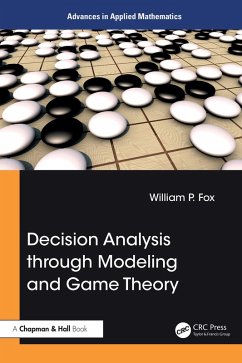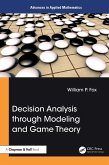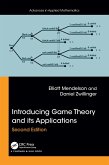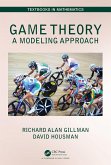Decision Analysis through Modeling and Game Theory (eBook, PDF)


Alle Infos zum eBook verschenken

Decision Analysis through Modeling and Game Theory (eBook, PDF)
- Format: PDF
- Merkliste
- Auf die Merkliste
- Bewerten Bewerten
- Teilen
- Produkt teilen
- Produkterinnerung
- Produkterinnerung

Hier können Sie sich einloggen

Bitte loggen Sie sich zunächst in Ihr Kundenkonto ein oder registrieren Sie sich bei bücher.de, um das eBook-Abo tolino select nutzen zu können.
This unique book presents decision analysis in the context of mathematical modeling and game theory. The author emphasizes and focuses on the model formulation and modeling-building skills required for decision analysis, as well as the technology to support the analysis.
The primary objective of Decision Analysis through Modeling and Game Theory is illustrative in nature. It sets the tone through the introduction to mathematical modeling. The text provides a process for formally thinking about the problem and illustrates many scenarios and illustrative examples.
These techniques and this…mehr
- Geräte: PC
- mit Kopierschutz
- eBook Hilfe
![Decision Analysis through Modeling and Game Theory (eBook, ePUB) Decision Analysis through Modeling and Game Theory (eBook, ePUB)]() William P. FoxDecision Analysis through Modeling and Game Theory (eBook, ePUB)73,95 €
William P. FoxDecision Analysis through Modeling and Game Theory (eBook, ePUB)73,95 €![Introducing Game Theory and its Applications (eBook, PDF) Introducing Game Theory and its Applications (eBook, PDF)]() Elliott MendelsonIntroducing Game Theory and its Applications (eBook, PDF)63,95 €
Elliott MendelsonIntroducing Game Theory and its Applications (eBook, PDF)63,95 €![The Golden Rule of Ethics (eBook, PDF) The Golden Rule of Ethics (eBook, PDF)]() Vladislav I. ZhukovskiyThe Golden Rule of Ethics (eBook, PDF)45,95 €
Vladislav I. ZhukovskiyThe Golden Rule of Ethics (eBook, PDF)45,95 €![Game Theory (eBook, PDF) Game Theory (eBook, PDF)]() Richard Alan GillmanGame Theory (eBook, PDF)46,95 €
Richard Alan GillmanGame Theory (eBook, PDF)46,95 €![Modeling Change and Uncertainty (eBook, PDF) Modeling Change and Uncertainty (eBook, PDF)]() William P. FoxModeling Change and Uncertainty (eBook, PDF)56,95 €
William P. FoxModeling Change and Uncertainty (eBook, PDF)56,95 €![Dynamics of Democratic Elections (eBook, PDF) Dynamics of Democratic Elections (eBook, PDF)]() Johannes MüllerDynamics of Democratic Elections (eBook, PDF)58,95 €
Johannes MüllerDynamics of Democratic Elections (eBook, PDF)58,95 €![Modeling Operations Research and Business Analytics (eBook, PDF) Modeling Operations Research and Business Analytics (eBook, PDF)]() William P FoxModeling Operations Research and Business Analytics (eBook, PDF)47,95 €
William P FoxModeling Operations Research and Business Analytics (eBook, PDF)47,95 €-
-
-
The primary objective of Decision Analysis through Modeling and Game Theory is illustrative in nature. It sets the tone through the introduction to mathematical modeling. The text provides a process for formally thinking about the problem and illustrates many scenarios and illustrative examples.
These techniques and this approach center on the fact (a) decision makers at all levels must be exposed to the tools and techniques available to help them in the decision process, (b) decision makers as well as analysts need to have and use technology to assist in the entire analysis process, (c) the interpretation and explanation of the results are crucial to understanding the strengths and limitations of modeling, and (d) the interpretation and use of sensitivity analysis is essential.
The book begins with a look at decision-making methods, including probability and statistics methods under risk of uncertainty. It moves to linear programming and multi-attribute decision-making methods with a discussion of weighting methods. Game theory is introduced through conflict games and zero-sum or constant-sum games. Nash equilibriums are next, followed by utility theory. Evolutionary stable strategies lead to Nash arbitration and cooperation methods and N-person methods presented for both total and partial conflict games.
Several real-life examples and case studies using game theory are used throughout. This book would be best used for a senior-level course in mathematics, operations research, or graduate-level courses or decision modeling courses offered in business schools. The book will be of interest to departments offering mathematical modeling courses with any emphasis on modeling for decision making.
Dieser Download kann aus rechtlichen Gründen nur mit Rechnungsadresse in A, B, BG, CY, CZ, D, DK, EW, E, FIN, F, GR, HR, H, IRL, I, LT, L, LR, M, NL, PL, P, R, S, SLO, SK ausgeliefert werden.
- Produktdetails
- Verlag: Taylor & Francis eBooks
- Seitenzahl: 314
- Erscheinungstermin: 8. November 2024
- Englisch
- ISBN-13: 9781040152928
- Artikelnr.: 72335750
- Verlag: Taylor & Francis eBooks
- Seitenzahl: 314
- Erscheinungstermin: 8. November 2024
- Englisch
- ISBN-13: 9781040152928
- Artikelnr.: 72335750
- Herstellerkennzeichnung Die Herstellerinformationen sind derzeit nicht verfügbar.
Books by William P. Fox from CRC Press:
Probability and Statistics for Engineering and the Sciences with Modeling using R
(w/Rodney X. Sturdivant, 2023, CRC Press
Mathematical Modeling in the Age of the Pandemic, 2021, CRC Press.
Advanced Problem Solving Using Maple: Applied Mathematics, Operations Research, Business Analytics, and Decision Analysis (w/William Bauldry), 2020, CRC Press.
Mathematical Modeling with Excel (w/Brian Albright), 2020, CRC Press.
Nonlinear Optimization: Models and Applications, 2020, CRC Press.
Advanced Problem Solving with Maple: A First Course (w/William Bauldry), 2019. CRC Press.
Mathematical Modeling for Business Analytics, 2018, CRC Press.
1.2 Decision Theory 1.3 Game Theory: Total Conflict Example 1.5: A Total
Conflict Game with Pure Strategies 1.4 Game Theory: Partial Conflict 1.5
Mathematical Modeling of Decisions 1.4 ILLUSTRATE EXAMPLES 1.5 Technology
Chapter 2 Decision Theory and Expected Value 2.1 Introduction 2.2 Expected
Value 2.3 Decisions Under Risk: Probabilities are known or estimated in
advance 2.4 Decisions under Uncertainty: Probabilities are not known nor
can they be estimated 2.5 Decision Trees 2.6 Sequential Decisions and
Conditional Probability (from Fox, Mathematical Modeling for Business
Analytics, Taylor and Francis, 2018) Chapter 3 Decisions under certainty:
Mathematical Programming Modeling: Linear, Integer, and Mixed Integer
Optimization 3.1 Introduction 3.2 Formulating Linear Programming Problems
3.3 Graphical Linear Programming 3.4 Linear Programming with Technology 3.5
Case Studies in Linear Programming Projects 3.5.1 Modeling of Ranking Units
using Data Envelopment Analysis (DEA) as a LP 3.5.2 Recruiting Raleigh
Office (modified from McGrath, 2007) Chapter 4 Multi-Attribute Decision
Making using weighting schemes with SAW, AHP and TOPSIS 4.1 Weighting
Methods 4.1.1 Rank Order Centroid (ROC) 4.1.2 Ratio Method for Weights
4.1.3 Pairwise Comparison (AHP) 4.1.4 Entropy Method: 4.2 Simple Additive
Weights (SAW) Method 4.3 Weighted Product Method 4.4 Analytical Hierarchy
Process 4.5 Technique of Order Preference by Similarity to the Ideal
Solution Methodology, Normalization, EXERCISES Chapter 4 CHAPTER 5 Game
Theory: Total Conflict 5.1 Introduction to Total Conflict Games 5.2 Models
with Pure Strategy Solutions 5.2.1 Movement Arrows with two players and a
payoff matrix: 5.2.2 Saddle Point Method 5.3 Dominance and Dominated
strategies Exercises Section 5.1 Pure Strategy Games 5.3 Mixed Strategy in
two player 2 strategy games 5.3 Linear Programming and Total Conflict Games
Chapter 6 Partial Conflict Games: The Classical Two-Player Games. Error!
Bookmark not defined. 6.1 Partial Conflict Simultaneous Games Introduction
6.2 The Prisoner's Dilemma 6.3 The Game of Chicken Chapter 7 Utility Theory
7.1 Introduction 7.2 Ordinal Numbers 7.3 Cardinal numbers 7.4 Utility 7.4
Von Neumann-Morgenstern Utilities Applied to Game Theory. 7.5 An
alternative approach to the lottery method in utility theory for game
theory 7.5.1 Lottery Method Illustrated 7.5.2 AHP Method 7.5.3 AHP Example
in Game Theory 7.6 Summary and Conclusions Chapter 8. Nash Equilibrium and
Non-Cooperative Solutions in Partial Conflict Games 8.1 Introduction 8.2
Pure Strategies and Dominance review in symmetric games 8.3 Equalizing
Strategies 8.4 Prudential Strategies with LP 8.5 Applications EXERCISES
Chapter 9 Evolutionary stable Strategies 9.1 Introduction Exercises Chapter
9 Chapter 10 Communications 10.1 Introduction 10.2 The Game of Chicken
Without Communication 10.3 The Game of Chicken With Communication 10.3.1
Moving First or Committing to Move First 10.3.2 Issuing a Threat 10.3.3
Issuing a Promise 10.4 Credibility Classical Game Theory and the Missile
Crisis (from Brahm ,1994) Theory of Moves and the Missile Crisis Chapter 10
Exercises Chapter 11 Nash Arbitration Method 11.1 Introduction to Nash
Arbitration 11.2 Methods without calculus 11.3 More than two strategies
11.4 Writer's Guild Strike example with cardinal numbers Introduction Nash
Arbitration Scheme Chapter 12 Three Person Games 12.1 Three Person Zero-Sum
games 12.2 Three-Person Partial Conflict Game ( Non-Zero Sum Game). 12.4
NON-ZERO Sum (non-constant sum) with no pure strategies. 12.5 3-Person game
with Technology Chapter 13 Extensive Form Games 13.1 Introduction Example
1. Kidnapping for ransom Applying TOM
1.2 Decision Theory 1.3 Game Theory: Total Conflict Example 1.5: A Total
Conflict Game with Pure Strategies 1.4 Game Theory: Partial Conflict 1.5
Mathematical Modeling of Decisions 1.4 ILLUSTRATE EXAMPLES 1.5 Technology
Chapter 2 Decision Theory and Expected Value 2.1 Introduction 2.2 Expected
Value 2.3 Decisions Under Risk: Probabilities are known or estimated in
advance 2.4 Decisions under Uncertainty: Probabilities are not known nor
can they be estimated 2.5 Decision Trees 2.6 Sequential Decisions and
Conditional Probability (from Fox, Mathematical Modeling for Business
Analytics, Taylor and Francis, 2018) Chapter 3 Decisions under certainty:
Mathematical Programming Modeling: Linear, Integer, and Mixed Integer
Optimization 3.1 Introduction 3.2 Formulating Linear Programming Problems
3.3 Graphical Linear Programming 3.4 Linear Programming with Technology 3.5
Case Studies in Linear Programming Projects 3.5.1 Modeling of Ranking Units
using Data Envelopment Analysis (DEA) as a LP 3.5.2 Recruiting Raleigh
Office (modified from McGrath, 2007) Chapter 4 Multi-Attribute Decision
Making using weighting schemes with SAW, AHP and TOPSIS 4.1 Weighting
Methods 4.1.1 Rank Order Centroid (ROC) 4.1.2 Ratio Method for Weights
4.1.3 Pairwise Comparison (AHP) 4.1.4 Entropy Method: 4.2 Simple Additive
Weights (SAW) Method 4.3 Weighted Product Method 4.4 Analytical Hierarchy
Process 4.5 Technique of Order Preference by Similarity to the Ideal
Solution Methodology, Normalization, EXERCISES Chapter 4 CHAPTER 5 Game
Theory: Total Conflict 5.1 Introduction to Total Conflict Games 5.2 Models
with Pure Strategy Solutions 5.2.1 Movement Arrows with two players and a
payoff matrix: 5.2.2 Saddle Point Method 5.3 Dominance and Dominated
strategies Exercises Section 5.1 Pure Strategy Games 5.3 Mixed Strategy in
two player 2 strategy games 5.3 Linear Programming and Total Conflict Games
Chapter 6 Partial Conflict Games: The Classical Two-Player Games. Error!
Bookmark not defined. 6.1 Partial Conflict Simultaneous Games Introduction
6.2 The Prisoner's Dilemma 6.3 The Game of Chicken Chapter 7 Utility Theory
7.1 Introduction 7.2 Ordinal Numbers 7.3 Cardinal numbers 7.4 Utility 7.4
Von Neumann-Morgenstern Utilities Applied to Game Theory. 7.5 An
alternative approach to the lottery method in utility theory for game
theory 7.5.1 Lottery Method Illustrated 7.5.2 AHP Method 7.5.3 AHP Example
in Game Theory 7.6 Summary and Conclusions Chapter 8. Nash Equilibrium and
Non-Cooperative Solutions in Partial Conflict Games 8.1 Introduction 8.2
Pure Strategies and Dominance review in symmetric games 8.3 Equalizing
Strategies 8.4 Prudential Strategies with LP 8.5 Applications EXERCISES
Chapter 9 Evolutionary stable Strategies 9.1 Introduction Exercises Chapter
9 Chapter 10 Communications 10.1 Introduction 10.2 The Game of Chicken
Without Communication 10.3 The Game of Chicken With Communication 10.3.1
Moving First or Committing to Move First 10.3.2 Issuing a Threat 10.3.3
Issuing a Promise 10.4 Credibility Classical Game Theory and the Missile
Crisis (from Brahm ,1994) Theory of Moves and the Missile Crisis Chapter 10
Exercises Chapter 11 Nash Arbitration Method 11.1 Introduction to Nash
Arbitration 11.2 Methods without calculus 11.3 More than two strategies
11.4 Writer's Guild Strike example with cardinal numbers Introduction Nash
Arbitration Scheme Chapter 12 Three Person Games 12.1 Three Person Zero-Sum
games 12.2 Three-Person Partial Conflict Game ( Non-Zero Sum Game). 12.4
NON-ZERO Sum (non-constant sum) with no pure strategies. 12.5 3-Person game
with Technology Chapter 13 Extensive Form Games 13.1 Introduction Example
1. Kidnapping for ransom Applying TOM







